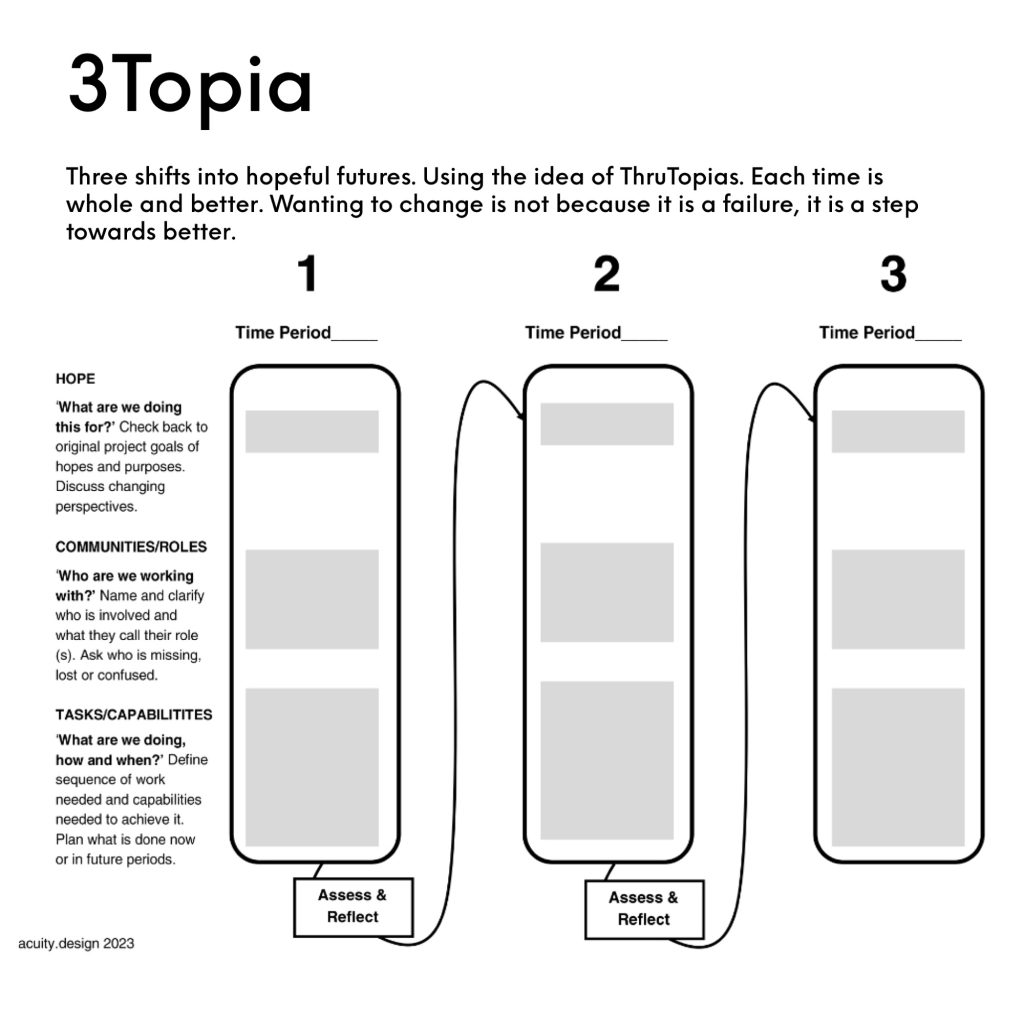
I just finished a project with the Royal Academy of Engineering in the UK and one thing that came up was how to shift teams and projects into alternative patterns of participatory design. The tools for such design are well known but how to access them from existing structures and then integrate them into new future work programmes is harder.
This post is just about the latter issue. How to bring tools of communal hope and shared imagination into processes of planning and delivery.
Take care
Context is important in all this. All tools and methods come from contexts of experience and knowledge. Most of the work I do in this area is context-shfting and in doing that I bring my own contexts along. When reading this, I am offering my own perspective and opinion on what can work and what has worked. However, this is all anchored to my social and educational background. I try to provide tools that enable personal autonomy and communal action. If you want to try and use any of these ideas and tools be aware of their pasts and their possible biases.
Hopeful Futures
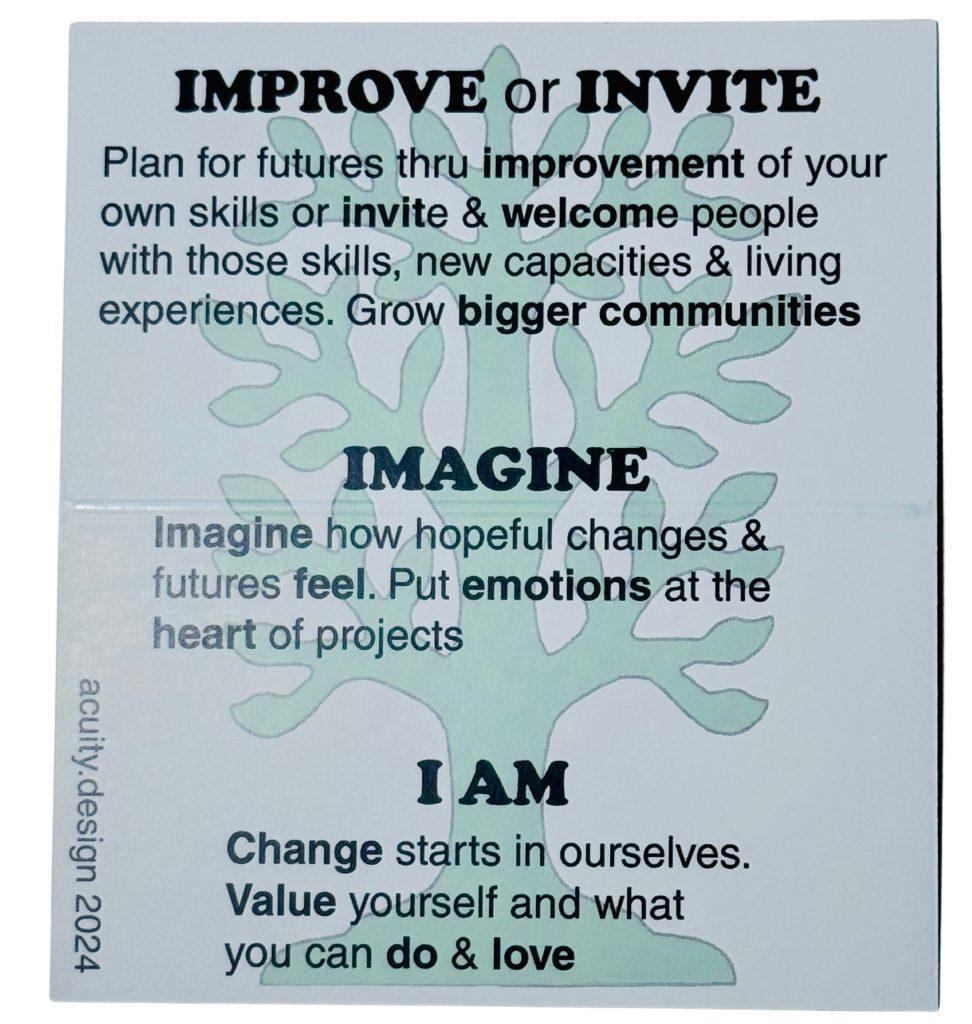
I worked in 2023 for the Design Council in the UK on use of Systemic Design Thinking tools in the Climate Crisis. I did this thru a series of in-person and online workshops to test language and tools with differing communities. One of the discoveries was the need to create a heart to any change project.
- A heart in a personal sense of affirming that an individual values themself and their ability to be part of a series of systemic changes
- A heart in communal sense of shared hopes and capabilities in a place over time.
Thus I have produced some facilitation materials and a workshop using a tree metaphor (first version at CampDigital and last version run in Copenhagen). Rooted in affirmation, a solid trunk of hope and imagination and many branches of personal improvements or communal invitations and welcomes. When running this workshop, this is summarised as follows.
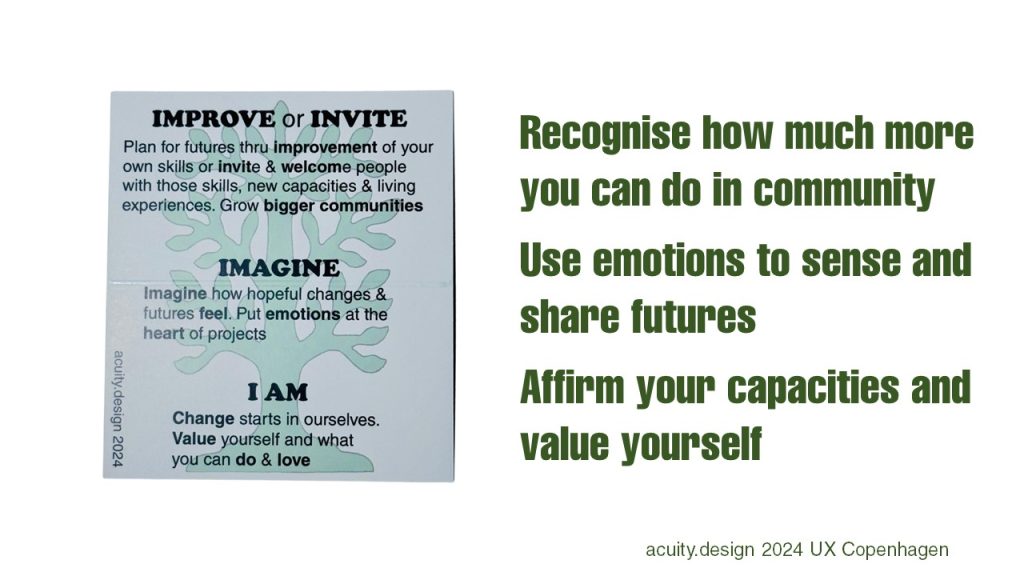
This hopeful futures approach is effective but it is not enough. Hope is achievable and thus there needs to be a way of mapping how we get from now to that hoped for future. This is what the 3Topia tool is for.
It is a combination of a couple of other frameworks that I find meaningful. This post is explaining what they are and how I have mixed them together.
Three Horizons
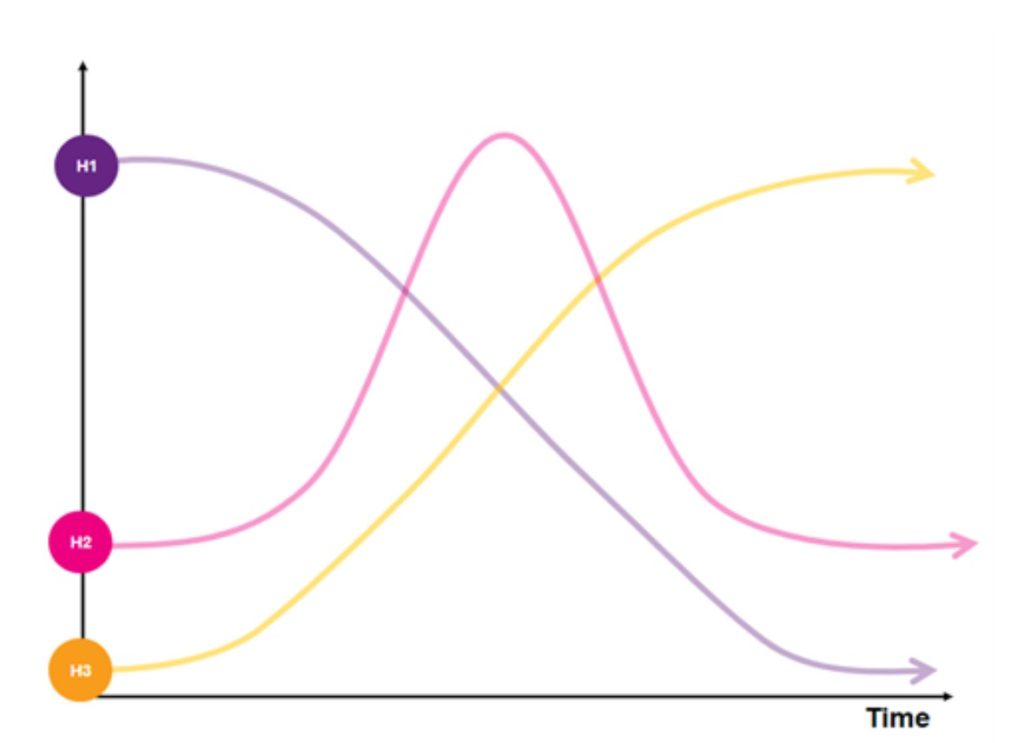
The three horizons framework was created by Bill Sharpe. This post by the NPC is very good on describing it – Three Horizons Framework.
The framework is a systemic design tool to try and sort the differing time streams of the present (H1), the future (H3) and the transition (H2). As noted in the NPC post:-
• Horizon 1 (H1) represents the current system, or the paradigm of ‘business as usual’.
• Horizon 2 (H2) represents innovations which, if appropriately developed, can help bring about a different system.
• Horizon 3 (H3) represents the desired future system.
The flow of graph lines shows a form of succession that reminds me of Permaculture. This is one slide from the UX Copenhagen 2024 workshop about Degrowth and Systemic Design.

Where I do find three horizons tricky is that it views time as separately but simultaneously experienced, rather than sequential. This can be hard to use with groups of people who live with calendars and causality. The framework is correct: people do imagine and anticipate futures (thru autonoetic consciousness) but it is not easy to talk and plan around graphed fragments of present, near future and far future.
Permaculture talks of designing in Wholes and this is why I add the idea of thrutopia to three horizons. A soldifying of time around a sequence of periods that people or communities pass thru.
Three horizons is a good framework for futurology but for project work I needed to manipulate it.
Thrutopia
Thrutopia is an idea I first heard about in a BBC Radio 3 broadcast of Free Thinking. I think it was invented by Rupert Read (or, at least, he wrote this helpful Medium post on it called Thrutopia).
It is a useful idea when people too often swivel nervously between Utopias and Dystopias.
They cannot commit to any action as they feel it will not be enough (the failed utopia) or have unforeseen consequences (the accidental dystopia). Thrutopia is a concept that allows futures to be imagined and planned thru stages. This is why it relates to the three horizons idea.
From the UX Copenhagen workshop, this is an earlier slide describing why Permaculture is a useful model. It is based on designing in wholes and thus the idea of thrutopias is helpful here. Each stage of change is whole in itself and should be treated as such.
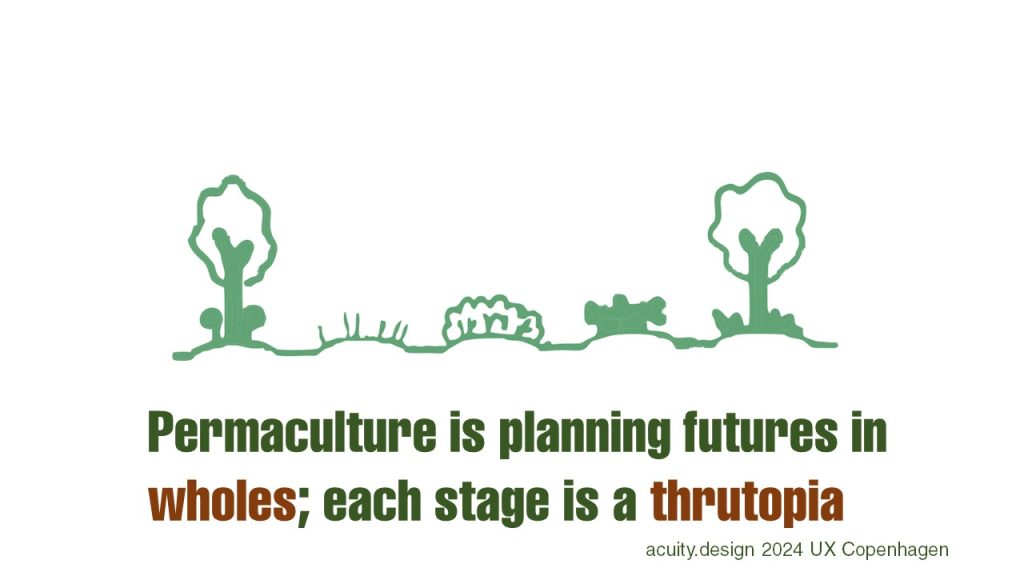
If all the stages of change are viewed as transitions then nothing seems solid. Everything is founded on shifting ground. This is not a helpful way of bringing people and communities along. They need to sense that the place is safe and complete; even when they know that there is better, future place.
This is why the 3Topia model uses three periods of time/place to anchor hopes, place and actions to. It is a plan of succession, as viewed thru three horizons framework, but it is centred around the sequential sense of time and causation that people encounter.
3Topia
Thus 3Topia is thus a mapping tool that combines two ideas to provide a way of thinking about how hopeful futures can be achieved. It is the grounding tool that is needed after using hope, emotion and imagination tools and linking those pieces to future times and actions.
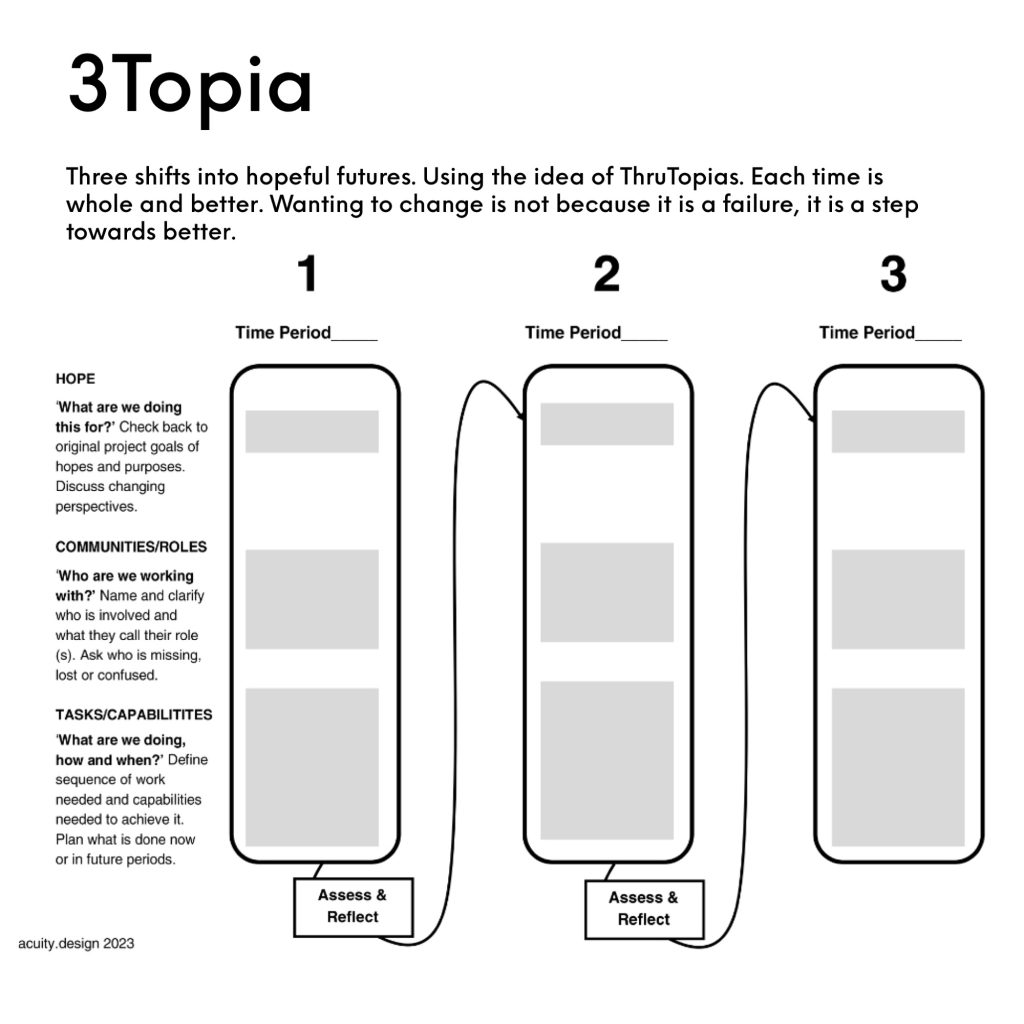
Each part of the process is based on another idea from Permaculture.

Permaculture is a Degrowth methodology. Innovation is the last resort. The changes we make are bounded by energy use. Thus every stage of change (at start and end of each period) is held by assessing and reflecting upon where this period is. Reflecting upon the orginal hopes that the project started with and assessing how the changes made have changed what is hoped for. Checking in with people and communities who are involved (remembering to affirm individuals, investing time and energy in what is working and inviting and welcoming more people in).
3Topia is thus a future envisioning tool for mapping what can be done and when but also an active refelection tool for how our hopes and activities change as we move thru time and achievements.
I hope this post has helped explain why this tool exists and how it can work in existing and new projects.
If you would like to know more about workshops or methods, please contact me.